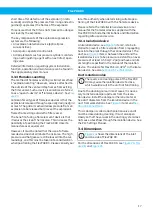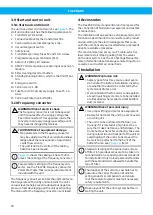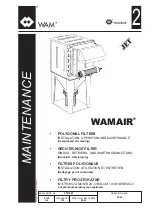
FlexPAK DX
short time after detection of the explosion (in milli-
seconds) and stops the pressure from rising and extin-
guishes (suppresses) the flames of the explosion.
This ensures that the filter is not stressed to a danger-
ous level by the explosion.
The key components of the explosion suppression
system are the following:
• An explosion detection device (optical/pres-
sure-sensitive).
• A computer-operated control unit.
• Action elements such as pressure cylinders contain-
ing an extinguishing agent with an extra fast open-
ing valve.
Detailed information regarding system installation,
function, operation and maintenance can be found in
the suppression system manual.
3.3.3 Flameless venting
The method of flameless venting is similar to method
1 “explosion venting”. However, a device attached to
the outside of the vent will stop flames from exiting
the filter vessel. Such a device is sometimes referred
to as a “quench-device” or “flameless-device”. See
.
Common for all types of flameless devices is that the
explosion is released through a specially designed grid
or mesh. The grid or mesh will allow pressure from an
explosion to be released but prevent the explosion’s
flames from exiting outside the filter vessel.
The benefit of using a flameless vent device is that
it reduces the size of the risk area. This increases the
possibility of positioning the FlexPAK DX closer to
manned areas or equipment.
However, it must be noted that the use of a flame-
less device does not eliminate the risk area. The high
pressure and hot gases are still released into the sur-
roundings, and this must be taken into consideration
when positioning the FlexPAK DX. Please consult your
local fire authority when determining suitable posi-
tioning of the FlexPAK DX with the flameless device.
Please refer to the installation and service or user
manual for the flameless device supplied with the
FlexPAK DX to find other limitations and information
regarding safe use and service.
3.3.4 Isolation device
An isolation device, see
, item 2, is to be in-
stalled to prevent a filter explosion from propagating
back into the plant through the connected duct. The
item 3, between the unit and the
isolation device, is to be pressure-resistant to an over-
pressure of at least 0,5 bar (7,2 psi) and have a minim-
um length as specified in the manual of the isolation
device. The volume for FlexPAK is 0,47m
3
in the isola-
tion device. See also
.
Duct isolation valve
The reverse air cleaning pulse of the FlexPAK
DX may cause the isolation device to close,
which would result in the unit not functioning.
Due to the cleaning pulse, in most cases, it is neces-
sary to install a damper upstream from the isola-
tion device. Install the damper either one meter or
five duct diameters from the isolation device in the
.
This is damper is called a duct isolation valve and it
must be closed during cleaning. It must also open
slowly so that the vacuum in the ducting system does
not cause a backflow through the isolation device. See
the PLC Settings Manual.
3.4 Dimensions
shows the dimensions of the inlet
and one side of FlexPAK DX.
For the dimensions of FlexPAK DX, see
17
Содержание FlexPAK DX
Страница 7: ...FlexPAK DX A E E A B C D G F 3A J I H 45 3B 7 ...
Страница 8: ...FlexPAK DX 13 12 10 9 7 8 2 1 3 4 6 5 11 4A 11 7 8 9 12 13 15 14 17 16 10 18 4B 8 ...
Страница 10: ...FlexPAK DX 6 A B 7 10 ...
Страница 13: ...FlexPAK DX 11 12 13 14 13 ...
Страница 14: ...FlexPAK DX A A A A C Min 2 1m 83 15 1 0 m 39 4 16 A B C 17 14 ...
Страница 36: ...www nederman com ...
















































